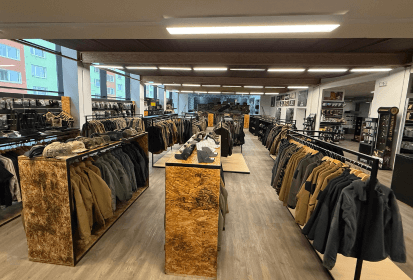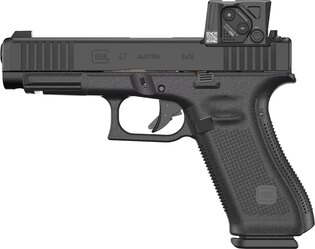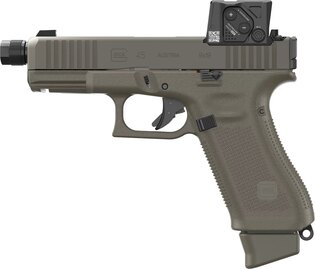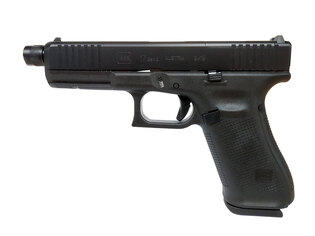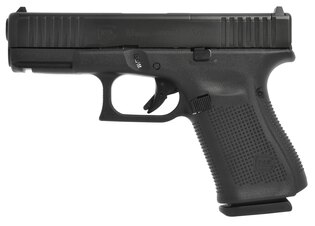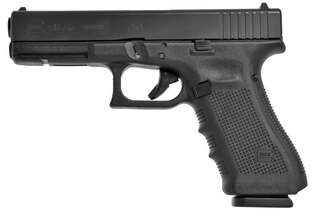The story of the legend called Glock
Probably most of us have already encountered Glock pistols. Some are serving with them, others are gaining experience in target shooting, and the others may have seen Glocks at least in thematic movies, where the popular pistols often get a supporting role. But do you know the story of Gaston Glock, who heralded a revolution in the arms industry?
First steps on the road to fame
The Glock company first saw the light of day in 1963. Of course, none other than the Austrian engineer and successful businessman Gaston Glock could have been responsible for its birth. The company gained more attention in the 1970s, when it began producing its very first military products. As part of production for the military sector, a whole range of knives (e.g. FM 78), cartridge cases, grenades, but also parts of machine gun cartridge belts were created.

The Glock company also produces knives, such as the FM 78 model.
Opportunity on the horizon
In 1980, Gaston Glock had an opportunity he couldn't refuse. The Austrian army was looking for a replacement for the outdated Walther P38 pistols, which were past their best years. As part of the selection process, the Austrian Ministry of Defense compiled a list of 17 key criteria that the new weapon must meet. Gaston's prototype was based, for example, on the following requirements:
- self-charging design,
- caliber 9×19 mm,
- magazine with a minimum capacity of 8 rounds,
- the weapon can also be operated with one hand when shooting,
- only 20 failures can be tolerated when firing 10,000 rounds,
- the weapon must not consist of more than 58 parts,
- all parts must be easily replaceable,
- when used correctly, discarded cartridges must not hit the shooter,
- the pistol must not accidentally fire when dropped from 2 meters onto an iron surface.
Within three months it was done. Glock's expert team, which consisted of members of the army, the police, but also civil engineers, created a functional prototype of the weapon, which it named the Glock 17. It then won over its competition during tests by the Austrian army. It must be added that there were no newcomers. Competitors included Heckler & Koch (pistols P7M8, P7M13 and P9S), SIG Sauer (pistol P220, P226), Beretta (pistol 92SB-F), FN Herstal (modernized version of Browning Hi-Power) and finally also Steyr (pistol GB).
Reliability in the main role
Glock was supposed to make a pistol for members of the military, police and other security agencies. The weapon therefore had to be ready to fire at the moment of danger to life. In addition, it was also necessary to protect the user from an unwanted shot. The design of the pistol therefore included three internal safety devices – the trigger, the firing pin and the above-mentioned safety device against falling.
Gaston Glock knew well that reliability goes hand in hand with simplicity. The first Glock 17 was therefore made of lightweight yet highly durable materials and consisted of only 35 parts, significantly fewer than competing pistols on the market today.
The successful 80s
After finalizing the weapon, Glock received an order to produce 25,000 pistols. Glock thus officially became the service pistol of the Austrian army. But Glock's enormous success was far from limited to the country in which it was created. Shortly after being accepted by the Austrian army, it began to penetrate beyond the borders, where it received an almost immediate acceptance in Norway and Sweden.
In 1984, the Glock 17 passed the NATO durability test, which opened the door to further expansion into the world market. A revolution in the pistol market has thus become a reality. Not long after that, Glock also succeeded in the American market, where more than 65% of federal, state and local authorities in the USA were re-armed with the Glock 17 pistol. In 1988, the 2nd generation of Glock pistols came on the market, which improved the grip of the weapon, there was also improvements to the return spring, the trigger and the introduction of a new magazine.

To date, there are a total of 5 generations of Glock pistols in circulation.
Constant development
The development of successful Glock pistols was understandably not limited to the 1980s. Gaston Glock did not rest on his laurels and responded to the evolving needs of the market. To date, there are a total of 5 generations of Glock pistols in circulation, which differ from each other. Some generations more, some less. The most important thing is that Glock offers a whole range of models from which almost everyone can choose. A big advantage of Glock pistols is tailor-made accessories, such as compact optical systems or tactical flashlights.
- Gen 1 - The very first generation of Glock pistols, recognizable by the lack of finger cutouts and the absence of any texture.
- Gen 2 - Added a more comfortable weapon grip that prevented slipping. New recoil spring, new magazine and improved trigger.
- Gen 3 - Introduced in 1996. The Glock newly received separate cutouts for the fingers and a bar on which a laser or flashlight could be attached.
- Gen 4 - Released on the market in 2010. There is an increase in the magazine release, a change in the texture of the grip or the addition of replaceable ridges, thanks to which it was possible to adjust the thickness of the grip according to the size of the hand. A big change was also the installation of a double return spring on the weapon, which reduced the recoil and enabled more accurate and faster shooting.
- Gen 5 - Coming to the world in 2017. The main distinguishing feature is the absence of finger cutouts. The bore of the barrel, the catch of the barrel, as well as the magazine, underwent a change.
Death of Gaston Glock
At the end of last year, the talented engineer and founder of Glock left us. Gaston Glock breathed his last on 27.12. 2023 at the age of 94. But his legacy will not be forgotten. The company continues to follow the legendary motto of its founder "Make it simple, make it perfect" and still commemorates his life's work.
Readers are further interested

